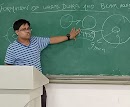Quantum
Understand the Quantization of Energy
Quantization, in mathematics and digital
signal processing, is the process of mapping a large set of input values to a
(countable) smaller set. As we know, in quantum mechanics everything is so
small which is really beyond our imaginations so, I think quantization is
a correct word for it. Classical physical theories had been tested
many times and seemed to describe reality tolerably. Not until later, when
these theories started to fall apart. The first phenomenon which classical
physics failed to explain is called the black body radiation. Black-body radiation is radiation
produced by heated objects, particularly from a kind of special object that is
made so it will absorb all radiation (visible light, infrared light, ultraviolet
light, etc.) that falls on it, and so that it will also radiate at all
frequencies that heat energy produces in it.
To understand this phenomenon, it
is necessary to know that all tangible bodies in the universe emit energy in
the form of electromagnetic radiation (light). The amount of energy emitted by
a body depends on several factors, such as temperature or colour of the body. The higher the temperature of a
body, the higher the average frequency (and thereby energy) of the light it
emits. The reason we usually can’t observe this radiation is that bodies at
room temperature emit predominantly light from the infrared spectrum, which is
not visible to the naked eye. Visible light is emitted by metals during
melting, for example, when their temperature reaches several hundreds of
degrees Celsius, making it possible for us to see them glow.
Physicists of the 19th century were trying to ascertain the spectral composition emitted by a body in relation to its temperature. To accomplish that, they used a simplified model of a body- the black body. A black body that has to meet the following two conditions:-
1. A black body stays in
thermal equilibrium with its surroundings (i.e. it has the same
temperature as all the bodies located within the system).
2. A black body absorbs all the
electromagnetic radiation that strikes it.
These conditions ensure that
spectrum emitted by a black body is determined purely by the temperature of the
body. However, when physicists tried to establish the composition of such a
spectrum using classical physics, they obtained a result that did not coincide
with reality whatsoever. According to classical physics, a black body would
emit the same amount of light of each frequency. However, the higher the
light’s frequency, the more energy the light has. A black body would therefore
emit huge quantities of energy in the form of high frequency radiation-infinite,
in fact.
This, however, has a dire
consequences- classical physics thereby basically states that every single
object in the universe should immediately emit all of its energy in the form of
light from the ultraviolet spectrum. Luckily the universe doesn’t work like
that, otherwise we would not exist.
The realisation was a
huge milestone for the evolution of modern science. Physicists were at last
unwillingly forced to admit that classical theories were simply wrong. Today,
we have apt name for this huge failure of classical physics- The ultraviolet
catastrophe.
 |
| Max Plank |
The black body radiation was
solved by a German physicist Max Planck. He came up with an idea that
bodies o not emit electromagnetic radiation continuously, but via small packets
called quanta. The size of these quanta is given is given by the following
equation:-
E= h .f
where, h is plank's constant and f is frequency.
Thanks for reading.....
Don't forget to check out my other articles and subscribe to this blog!!!
Join me on my social media handles and ask your doubts about the subject freely!!!
You can directly talk with me on Instagram
To meet more physics Enthusiasts please join our Facebook Page
To meet more physics Enthusiasts please join our Facebook Page
Also for latest updates of my posts join me on Twitter
See you next time!!!
-Ratnadeep Das Choudhury
Founder and Writer of The Dynamic Frequency














0 Comments